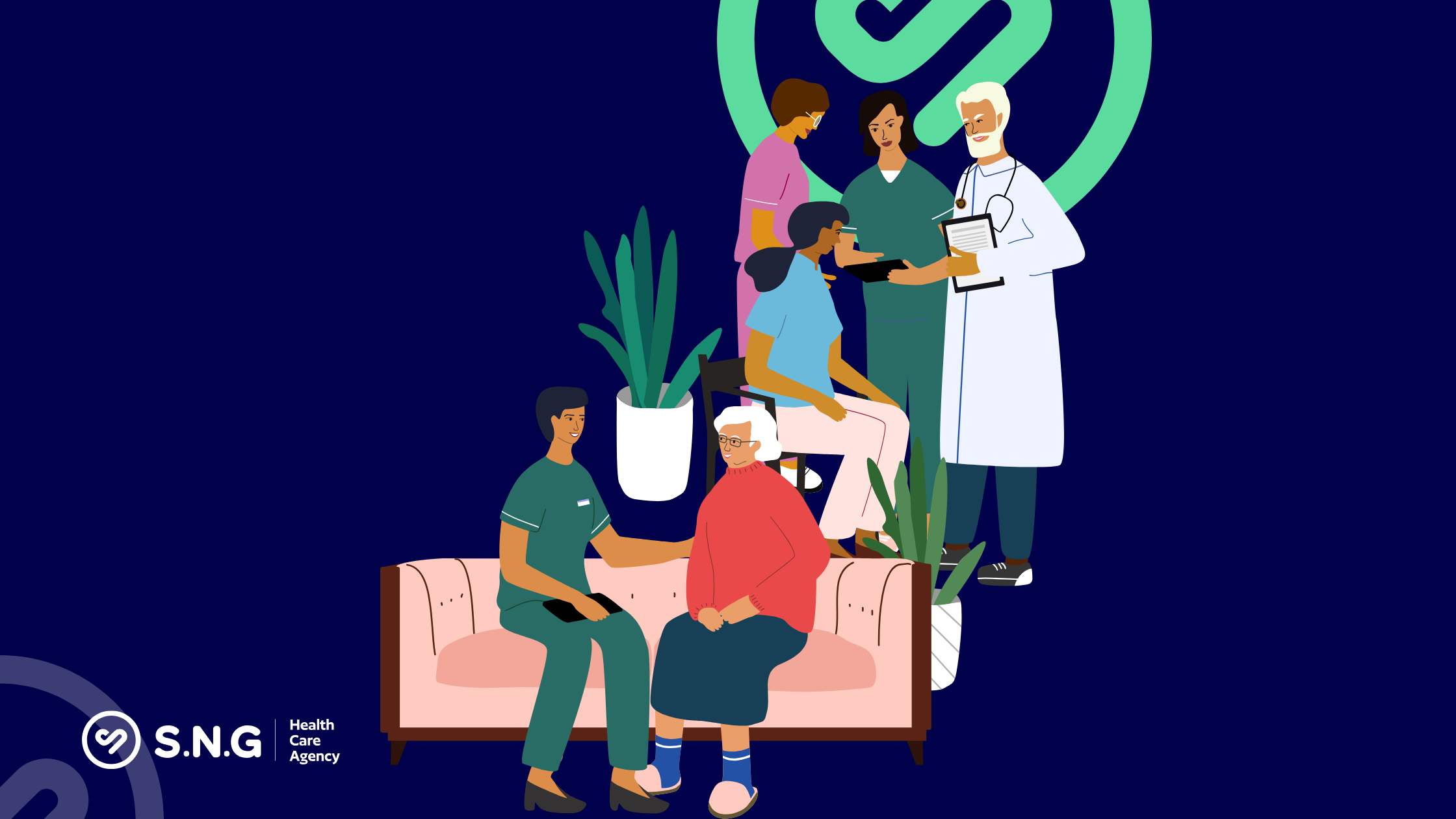Healthcare and social care in the UK are often spoken about as one system, yet anyone who has worked a night shift in a dementia home, supported a young person in a children’s residential, or led an MDT around a complex discharge knows they are often distinct worlds with shared purpose. For candidates considering a career and for experienced professionals planning their next move, understanding how these domains differ, where they overlap, and how integration and co‑production are reshaping practice is essential.
At SNG Healthcare, we support CQC and Ofsted regulated care services across the UK, including care homes, dementia homes and children’s residential services. We supply Registered Managers, Deputy Managers, Team Leaders, Support Workers and Mental Health professionals who thrive in multidisciplinary teams. Drawing on the experiences of these people, our own sector research and day‑to‑day experience, this article unpacks the ins and outs of both healthcare and social care.
1) What the Domains Are: A High‑Level View
Healthcare
Healthcare in the UK is largely delivered by the NHS. It focuses on preventing, diagnosing and treating illness or injury.
- Core settings: GP practices, acute and community hospitals, mental health trusts, community nursing and allied health services.
- Core activities: clinical assessment, diagnostics, treatment, rehabilitation and ongoing management of health conditions.
- Funding and governance: nationally planned and funded through taxation; overseen by NHS bodies (e.g., Integrated Care Board (ICBs) for commissioning and planning).
Social care
Social care supports people to live well and independently, addressing practical, social and emotional needs.
- Core settings: residential care and nursing homes, supported living, domiciliary care, children’s residential services, short breaks and day services.
- Core activities: personal care, daily living support, safeguarding, advocacy, community participation and outcomes‑focused planning.
- Funding and governance: locally assessed and means‑tested; planned and commissioned by local authorities with delivery by council, independent and voluntary providers.
These two systems frequently serve the same person—but they start from different mandates and funding arrangements. That is the source of both friction and opportunity.
2) How Health and Social Care Differ
While collaboration is growing, the structural differences remain real and matter to everyday practice.
- Purpose and focus
- Health: clinical diagnosis, treatment and prevention; time‑limited episodes of care often driven by medical need.
- Social care: sustained, person‑centred support aimed at independence, safety, dignity and quality of life.
- Funding model
- Health: universal, tax‑funded, free at the point of use.
- Social care: means‑tested with user contributions; shaped by local eligibility criteria.
- Governance and accountability
- Health: nationally planned and performance‑managed through NHS frameworks.
- Social care: locally planned by councils; market‑shaped across independent and voluntary providers.
- Data and systems
- Health: multiple NHS record systems with varying interoperability.
- Social care: diverse provider systems and council case management; historically limited data sharing with the NHS.
- Workforce culture and language
- Health: clinical hierarchies, diagnostic pathways and outcomes tied to clinical indicators.
- Social care: relational practice, strengths‑based language, outcomes defined by what matters to the person.
For candidates moving between sectors, recognising these cultural and systemic differences helps you adapt quickly and work effectively with partners.
3) How They Are Similar
Despite their differences, health and social care share a common ethos and many practical touchpoints.
- Person‑centred practice: starting with goals and preferences, not services.
- Safeguarding: statutory duties to protect children and adults at risk.
- Multidisciplinary teamwork: planning and delivering care with colleagues from multiple professions.
- Quality and regulation: governed by standards (e.g., CQC‑regulated settings) and continuous improvement.
- Public value: reducing inequalities, improving outcomes and using resources responsibly.
- Professional resilience: shift work, complex decision‑making and emotionally intelligent practice are part of both worlds.
These similarities are the bedrock upon which effective integration is built.
4) Working Together—In Practice, Not Just Policy
The creation of Integrated Care Systems (ICSs) in England has accelerated joint working by bringing the NHS, local authorities, providers and the voluntary sector into shared planning and delivery. Yet true integration is what happens (or doesn’t) at the bedside, in the home and around the kitchen table. Here are practical examples we see daily:
- Hospital discharge that sticks: Shared discharge planning, with social workers, ward therapists, community nurses and care‑home staff agreeing realistic goals, equipment and follow‑up. This reduces readmission risk and supports safe transitions.
- Dementia‑friendly pathways: Memory clinic teams, GPs, community mental health services and dementia homes co‑producing plans with families, aligning medication reviews, behavioural support and meaningful activities.
- Keeping children safe and thriving: Children’s residentials collaborating with CAMHS, education and social workers to stabilise placements and support therapeutic plans, reducing crises and improving long‑term outcomes.
- Preventing unnecessary admissions: Falls prevention across neighbourhood teams—home carers spotting early risks, rapid response therapy input, and GP escalation when needed, keeping people well at home.
Popular belief says “the NHS does health and councils do care: end of story.” Reality is more nuanced: when teams share information, plan together and respect each profession’s strengths, outcomes improve and resources go further. Frontline staff, not structures, make integration real.
5) Co‑production: Power With, Not Power Over
Co‑production is more than involvement, it’s a shift in power. People and families design, deliver and evaluate support alongside professionals from the outset.
What it looks like in practice:
- Goals set by the person: Care plans reflect what matters, maintaining a pet routine, getting to church on Sundays, or a young person’s GCSE ambitions, not just clinical tasks or minutes of personal care.
- Shared expertise: A parent’s insight into a child’s triggers carries the same weight as a clinician’s assessment. Both are essential to a workable plan.
- Accessible participation: Meetings at times people can attend, jargon‑free language, interpreters where needed and clear feedback loops.
- Reciprocity: Lived‑experience partners are trained, paid and supported to contribute as equals.
Why it works:
- Better fit = better outcomes: Plans people help design are more likely to be followed.
- Earlier problem‑solving: Families and support workers spot issues quicker than any dashboard.
- Staff satisfaction: Practitioners experience fewer conflicts when the plan genuinely reflects the person’s life.
Co‑production aligns naturally with integration: if services are to join around the person, the person must be at the centre—defining success.
6) Barriers to Integration and How Teams Overcome Them
Research highlights persistent challenges: funding disparities between health and social care, fragmented structures, professional silos and digital barriers. On the ground, successful teams mitigate these by:
- Building common language: Using strengths‑based, plain English across agencies; translating jargon so everyone can contribute.
- Sharing information lawfully and purposefully: Using shared care records or agreed information‑sharing protocols so people don’t repeat their story.
- Co‑locating where possible: MDTs that share physical or virtual space make faster, better decisions.
- Investing in skills: Digital literacy, trauma‑informed practice, and community asset mapping sit alongside core clinical or care competencies.
- Focusing on outcomes, not ownership: The question shifts from “Is this health or social care?” to “What outcome are we trying to achieve, and who is best placed to lead?”
7) Careers, Skills and Progression: Practical Guidance
Whether you’re entering the sector or moving across it, there are clear opportunities and evolving pathways.
Roles we place at SNG Healthcare:
- Registered Managers, Deputy Managers, Team Leaders: Leading services in care homes, dementia homes and children’s residentials; driving quality, compliance and culture.
- Support Workers, RCWs: Providing daily living support, relationship‑centred care and early escalation to clinical partners.
- Mental Health professionals: From RMNs to Psychological Wellbeing Practitioners; supporting crisis prevention, recovery and community inclusion.
Skills that make you effective across both domains:
- Person‑centred planning and communication: Listening first, planning second.
- Risk enablement: Balancing safety with independence and positive risk‑taking.
- Multidisciplinary teamwork: Confidence to contribute your perspective and respect others’.
- Digital confidence: Using e‑MARs, care planning systems and shared records appropriately.
- Safeguarding and legal literacy: Understanding the Care Act, Mental Capacity Act and Children Act principles in day‑to‑day decisions.
Progression pathways to consider:
- From Support Worker to Senior/Team Leader and into Deputy/Registered Manager roles.
- Specialist tracks (e.g., dementia practice lead, PBS practitioner, safeguarding specialist).
- Cross‑sector moves (e.g., community mental health to children’s residential or vice versa) where your skills transfer well.
What we do to help candidates:
- Honest role matching: We assess your strengths and preferences to place you in services where you can thrive.
- Preparation: Interview coaching, compliance guidance, and realistic day‑in‑the‑life briefings for each setting.
- Ongoing support: Shift flexibility, reflective check‑ins and opportunities to broaden your experience across different services.
8) What Providers Can Expect from SNG Healthcare
Providers are under pressure to deliver safe, person‑centred care while contributing to system‑wide integration goals. We partner with you on both.
- Workforce that enables integration: We supply people comfortable in MDTs and confident using shared systems and outcomes frameworks.
- Sector‑specific expertise: From CQC expectations to crisis‑stabilisation in children’s homes, our teams understand the practical realities of each setting.
- Reliable compliance: Rigorous checks, up‑to‑date training and clear documentation—right first time.
- Rapid mobilisation: Short‑notice cover without compromising quality, plus ongoing recruitment strategies for stability.
Our aim is not just to fill a rota, but to strengthen your service’s capability to collaborate across the local health and care system.
9) Similarities, Differences and the Path Ahead—A Quick Recap
- Different by design: The NHS and local authorities have distinct funding, governance and mandates.
- Similar in values: Person‑centred practice, safeguarding, quality and teamwork are shared foundations.
- Better together: Integration through ICSs and neighbourhood teams works when frontline staff share information, plan jointly and respect each other’s expertise.
- Co‑production is the engine: Power‑sharing with people and families turns integration from structure into practice.
- Skills are evolving: Digital fluency, community engagement and collaborative problem‑solving sit alongside core clinical and care skills.
Conclusion
Health and social care are not the same, and that’s a strength when we collaborate well. Health brings clinical expertise; social care brings sustained, relational support. When services integrate around what matters to the person, outcomes improve, resources stretch further and staff satisfaction grows. Co‑production ensures the person is the author of their plan, not just a subject of it.
For professionals, this is a moment of opportunity: clear pathways, rich roles and the chance to make integration real at neighbourhood level. For providers, it’s a call to invest in teams who can work across boundaries with confidence and compassion.
SNG Healthcare stands with both. We know the pressures and the pride of this work, from the first morning handover to the last call of the night. Whether you are a Registered Manager shaping culture, a Support Worker making the difference hour by hour, or a Mental Health professional stabilising a crisis, we are here to back you. If you’re ready for your next step, or you need a partner who understands your service, please send us a message.
Keywords: Healthcare and Social Care, NHS, local authorities, Integrated Care Systems (ICS), co‑production, integration, Registered Manager, Support Worker, Mental Health professional, care homes, dementia homes, children’s residentials, careers in care.


